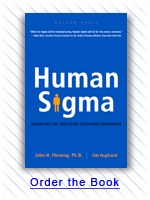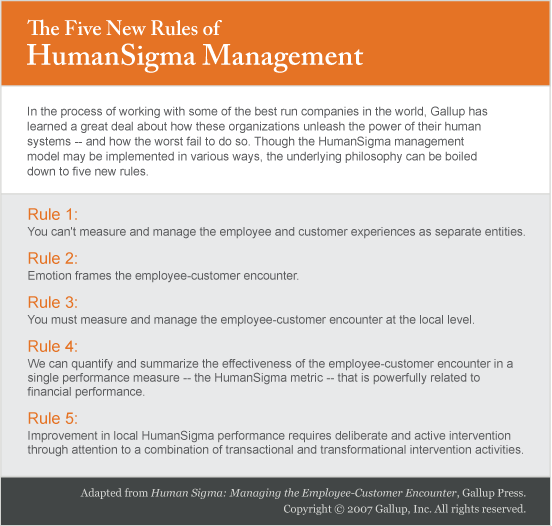Decades of research on managing the human element of business -- including interviews with more than 10 million customers and 10 million employees -- can be boiled down to the "Five New Rules of HumanSigma Management." These five rules suggest a new approach for getting the most out of those moments when your employees encounter your customers.
So say John H. Fleming and Jim Asplund, authors of Human Sigma: Managing the Employee-Customer Encounter. Their book details some of the ways the world's best performing organizations measure, manage, and improve the points of contact between their employees and their customers to drive dynamic financial performance. In this article, the final in a series about the five rules, we explore Rule 5: Improvement in local HumanSigma performance requires deliberate and active intervention through attention to a combination of transactional and transformational intervention activities.
 "Sometimes change requires an earth-shattering or disruptive act." Fleming and Asplund's statement now seems prophetic. Human Sigma hit the shelves in 2007, prior to what is arguably the greatest global economic crisis since the Great Depression. Companies from every industry and of every size and stature are dealing with economic issues that easily merit the definitions "earth-shattering" and "disruptive," and the resulting changes have been almost uniformly negative.
"Sometimes change requires an earth-shattering or disruptive act." Fleming and Asplund's statement now seems prophetic. Human Sigma hit the shelves in 2007, prior to what is arguably the greatest global economic crisis since the Great Depression. Companies from every industry and of every size and stature are dealing with economic issues that easily merit the definitions "earth-shattering" and "disruptive," and the resulting changes have been almost uniformly negative.
But the kind of organizational change that Fleming and Asplund are calling for -- however disruptive it might feel while it is happening -- is ultimately positive. Applying the five rules of HumanSigma management to transform a company's human systems performance paves the way for a business to maximize its employee-customer encounters and the financial rewards its enhancements deliver. The financial downturn forced change on organizations. In contrast, moving to a HumanSigma management approach enables companies to initiate positive change by embracing and effecting disruptive actions.
Not every action that companies take to improve their employee-customer encounters needs to be drastic. Simple solutions exist, but they must be consistently applied to achieve maximum impact. Still, as the authors found in their research, a combination of tactical actions and more complex plans implemented at every level of an organization can help companies create positive change. These efforts are both transactional -- regularly occurring actions and efforts that are short-term or limited in scope -- and transformational -- in-depth activities and actions that fundamentally modify a company's human systems. Together, they create the kind of sustainable improvement so badly needed by so many organizations in this global economic climate.

Changes in human systems management
This series of articles highlights companies that have taken significant steps to improve their employee-customer encounters -- steps that people both inside and outside these organizations might have considered radical or extreme. But the radical improvements they achieved were driven by transactional and transformational actions. Before embarking on a HumanSigma initiative, the leaders in these organizations, as well as representatives from similar companies Gallup has worked with around the world, realized that to enact real change, they would have difficult work to do. And most of these leaders had to prepare their organizations for the profound differences to come.
Driving transformational change relies on taking recognition and encouragement to the next level.
A key element of this preparation, Fleming and Asplund say, comes from addressing your organization's human systems management. Most companies are organized by functions -- such as operations, human resources, and sales and marketing -- which can splinter from one another and work in isolation. "Because they are inwardly focused, it's possible for the business objectives of one functional area to be at odds with another. This can create drag, inefficiency, waste, or even more dire consequences," the authors write. Such consequences include failing to fully optimize the relationship between the two key constituencies in any organization -- customers and employees.
The solution, or at least an important aspect of the answer, is to rethink how your organization structures itself around function, then realign your company based on its human systems. "Human systems do not conform to strict functional silos or traditional organizational lines," the authors write. They suggest that companies consider consolidating management of their human systems under one person -- a Chief HumanSigma Officer -- who can take responsibility for and drive performance in all of a company's human systems.
"To manage and leverage your company's human systems effectively to drive productivity, profitability, and growth, responsibility for customer and employee outcomes -- and the employee-customer encounter itself -- should be housed within a single entity with broad authority and resources to promote organizational change," they write.
Restructuring core areas of your business might be a radical measure, but that isn't the only effort necessary to improve the employee-customer encounter. Evaluation, intervention, and encouragement, the authors note, are required for organizations to achieve and maintain performance excellence across all their human systems.
Evaluation
In Human Sigma, Fleming and Asplund offer specific examples of the basic and more in-depth evaluative steps organizations can take to maximize their understanding of their human systems. These include indentifying:
-
how -- and how often -- to measure employee and customer engagement levels
-
what to measure and how to analyze the data
-
ways to share customer and employee feedback data with an organization's customer-facing units
-
how to supplement quantitative data with qualitative conversations and understanding
-
how to measure employee engagement at the work unit level and create impact plans to improve engagement
-
how to use all of the data available to develop a three-year action plan
It's important to note that evaluation becomes transformational only when measurement leads to action. "Measurement only improves performance when it's acted upon," the authors write. "Measurement is a necessary step, but it's only the first step toward meaningful organizational change."
Intervention
The next stage -- intervention -- is where an organization's commitment to HumanSigma is tested. Intervention efforts, which rely on the participation, initiative, and imagination from local work units, are where "the seeds of dramatic organizational change are planted."
Clear communication about employees' role in the intervention process is key to its success. "Employees need to know what engagement is and how it will benefit everyone involved," the authors write. And transactional activities -- such as aligning the organization's brand promise, action planning and action plan review, and implementing customer advisory boards -- all play an important role in improving performance.
These types of actions lead to fundamental changes, including creating a culture of accountability throughout the organization, developing individuals' unique talents and strengths, and improving organizational effectiveness by hiring associates with the right talents to succeed in their roles. These aren't the only types of transformational activities borne from organization-wide interventions; taking actions based on the organization's evaluations using a trial-and-error process will produce transformational strategies.
Encouragement
After the measurements begin and the interventions are in place, encouragement is a vital catalyst for continued improvement. "Celebrating successes helps institutionalize improvement by establishing the language and culture of engagement," the authors write, adding that cheerleading is critical to the change process. Integrating HumanSigma performance criteria in an organization's recognition programs will reinforce the importance of these changes, as will transactional activities such as determining employees' preferred types of recognition, celebrating the top-performing work units, encouraging local celebrations and recognition, and offering a formalized rewards structure.
But driving transformational change relies on taking recognition and encouragement to the next level. This includes actions such as organizing peer group mentors so top performers can encourage low performers, hosting retreats to foster discussion about what it takes to be a top-performing unit, and linking performance to advancement and promotion opportunities.
Many of these ideas may seem like familiar strategies and solutions. And concepts such as "evaluation, intervention, and encouragement" sound simple enough. But the transactional and transformational activities through which organizations must improve their human systems performance often require radical changes and behaviors for which there is no precedent.
If the economic problems of the past few years are any indication, just doing what's always been done won't enable organizations to improve their performance and grow their business. Sometimes change requires drastic action, both transactional and transformational.